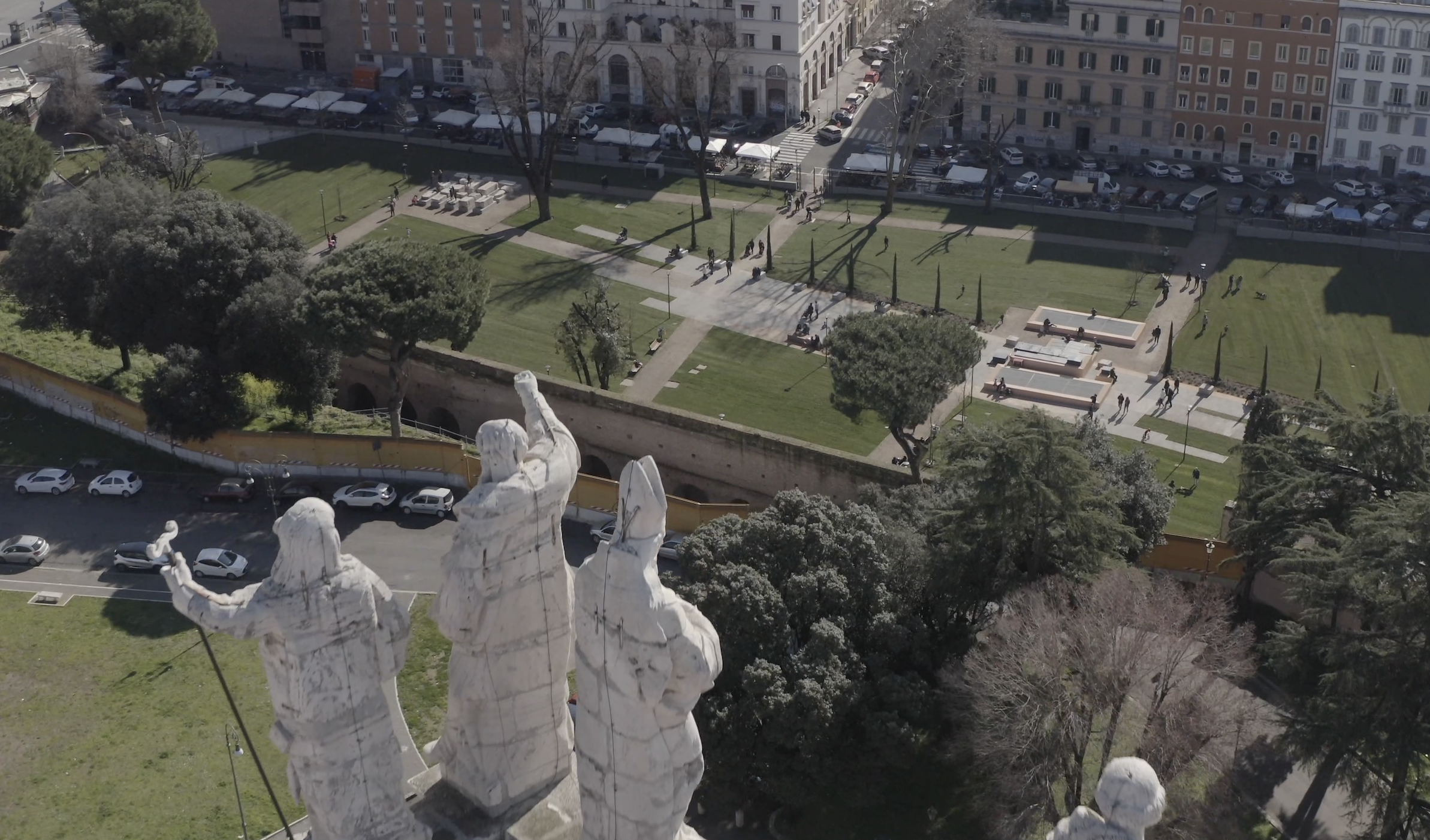The Multifunctional Shaft 3.3: on February 18, the gardens of Via Sannio were reopened to the public
The Multifunctional Shaft, called 3.3, is located between the Amba Aradam/Ipponio and San Giovanni stations, adjacent to a garden area next to the historic local market of Via Sannio, on the side of Piazzale Appio.
On February 18, 2021, the area of the new gardens of Via Sannio, covering 9,000 square meters near the Aurelian Walls, was opened to the public.
A completely renovated and revitalized space, just steps away from the Basilica and the San Giovanni Line C station. The garden redevelopment project is the result of synergistic work between Rome Capital, the Special Superintendency for Archaeology, Fine Arts, and Landscape of Rome, Metro C ScpA, and Rome Metropolitane. The Superintendency believed that the area’s arrangement should be an opportunity to showcase some of the archaeological discoveries made during the excavations. It therefore requested that the outlines of the wall structures and the traces of the river be reproduced on the ground, without reconstructions, but with materials suitable for a public park setting.
The Multifunctional Shaft 3.3
On June 18, 2021, Metro C ScpA delivered to Rome Capital the Multifunctional Shaft called 3.3, located in the Gardens of Via Sannio, for pre-operation under Atac’s responsibility.
The Shaft is located between the Amba Aradam/Ipponio and San Giovanni stations, adjacent to the gardens next to the historic local market of Via Sannio.
The activation of Shaft 3.3 will allow achieving the optimal configuration of the San Giovanni terminus by adding 4 new railway switches. This will enable Line C trains in operation to pass quickly and efficiently from one track to another, simplifying and speeding up the so-called “tail reversal at the terminus” of the trains.
Shaft 3.3 represents the terminal of the fourth functional phase of the entire Montecompatri Pantano – San Giovanni line (Shaft 3.3) and is the first shaft built in the T3 San Giovanni – Fori Imperiali section.
The structure integrates with the surface arrangement of the gardens in harmony with the surrounding context.
Conference of Services for the Approval of the Final Project of the Venice – Fori Imperiali/Colosseo Sub-Functional Section of Line C
On August 3, 2021, the Conference of Services concluded, approving the Final Project of the Colosseo/ Fori Imperiali – Venezia section of Line C of the Rome Metro.
The expressed prescriptions will be incorporated and developed in the executive project, the elaboration of which will begin after the approval of the necessary funding for the implementation of the works.
The final design of the Venezia station, along with that of the entire T2 section, had been suspended by Roma Metropolitane in March 2010, following the results of the archaeological investigations of the First Phase. Between 2013 and 2014, following the partial restart of the design for the Venezia station alone, Metro C ScpA drafted two different versions of the final project.
The close and constant collaboration between the General Contractor Metro C S.C.p.A. and the Archaeological Superintendency of Rome, together with the guidelines of the Technical Scientific Committee for Archaeological Heritage, led to the development, for the first time in Italy, of a document called the “Handbook of Second-Phase Archaeological Investigations.”
The handbook was drafted by Metro C S.C.p.A. during the final design phase, based on the results obtained from the first-phase archaeological investigations, and it defined, in agreement with the Archaeological Superintendency, the excavation methods and removal methods for the ancient structures found at each site.
The new approved Final Project is the result of integrations and modifications arising from additional specific needs and objectives identified in January 2020 by various public entities involved:
– The study of preparations for adequate interface with the future Clodio/Mazzini-Venezia section;
– The study of design solutions suitable to ensure Venezia Station as a transfer hub with the future Line D;
– The construction of underground connections with Palazzo Venezia and the Vittoriano, with the aim of connecting the station to the two architectural and museum complexes;
– The design of a museum installation within the station for the already-discovered archaeological complexes and artifacts that will emerge during the planned excavation for the station. An entire level of the station is dedicated to this purpose.
– The expansion of the excavation of the Atheneum of Hadrian and the construction of an underground connecting gallery between the Atheneum and the archaeological area of the Basilica Ulpia and Trajan’s Column.
The new project, with the requested integrations and modifications, was drafted and delivered by Metro C ScpA in May 2020 and, in January 2021, transmitted by the Mobility and Transport Department of Rome Capital to the Ministry of Infrastructure and Sustainable Mobility for funding requests.


